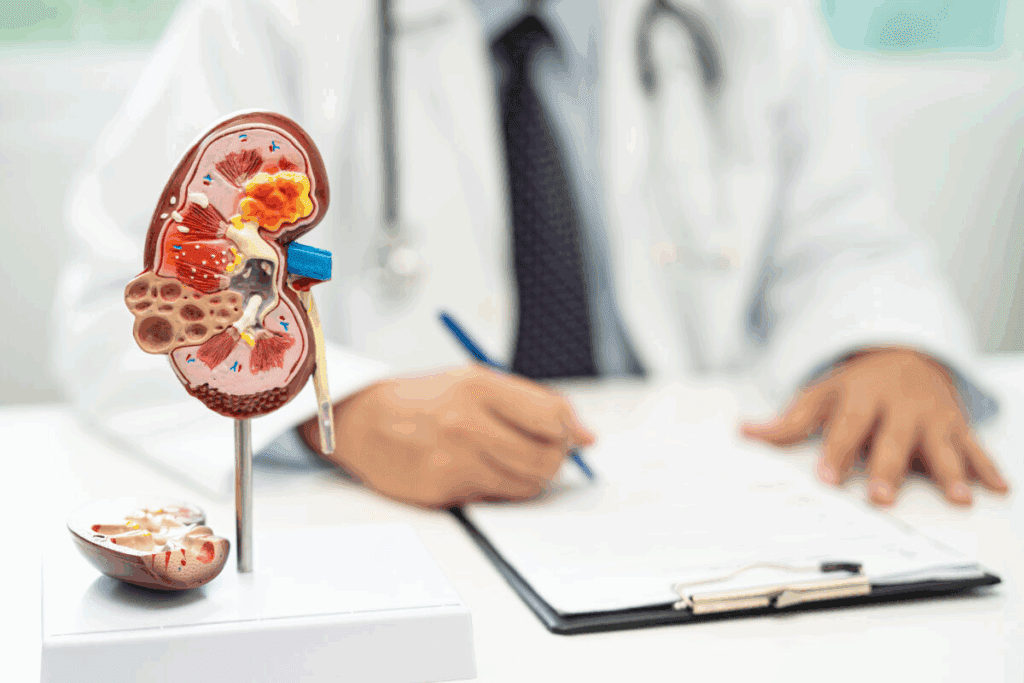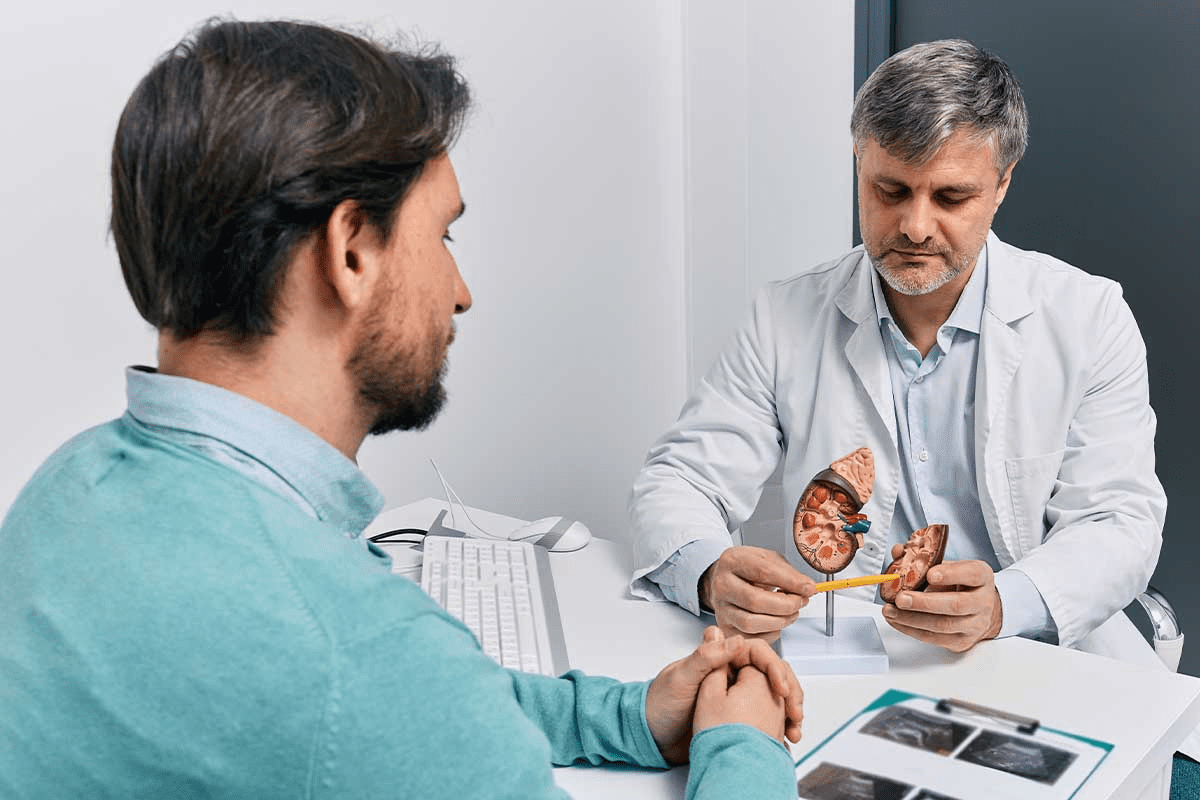Last Updated on October 31, 2025 by Bilal Hasdemir

Kidney stone disease is a common issue affecting millions globally. It’s vital to know the warning signs to get timely medical help and avoid serious problems.
Recognizing symptoms early can greatly improve treatment results. Mr. Ivo Dukic, a urological surgeon, says early detection is essential. It helps avoid severe pain and complications from kidney stones
Is a kidney stones bloated stomach a symptom? Learn 7 key signs of kidney stones you shouldn’t ignore and when to seek urgent care..
At Liv Hospital, we use international expertise and focus on the patient. We ensure top-notch care for kidney stone diagnosis and treatment. Our methods are based on the latest medical research.

Kidney stones are hard deposits made of salts and minerals. They form inside the kidneys. The size and type of stone can affect how severe the symptoms are and the treatment needed.
Kidney stones are classified based on their composition. The main types are calcium stones, uric acid stones, struvite stones, and cystine stones. Each type has its own causes and risk factors. For example, calcium stones are linked to diet and metabolic issues.
Kidney stones are common worldwide. Some people are more likely to get them due to genetics, diet, and health conditions. Dehydration, a diet rich in sodium and animal protein, obesity, and conditions like gout or inflammatory bowel disease raise the risk. Knowing these risk factors helps in preventing and catching kidney stones early.

Kidney stones form when there’s an imbalance in the concentration of substances in the urine. This imbalance can lead to the crystallization of these substances, forming hard deposits.
The formation of kidney stones is a complex process. It starts with the concentration of certain substances in the urine, like calcium, oxalate, and uric acid. When these substances become too concentrated, they can crystallize and form small, hard deposits. Factors that increase the risk of kidney stone formation include dehydration, dietary habits, and certain medical conditions.
Risk Factor | Description |
Dehydration | Low fluid intake leading to concentrated urine |
Dietary Habits | High intake of salt, animal protein, and oxalate-rich foods |
Medical Conditions | Conditions like hyperparathyroidism, cystic kidney diseases |
Kidney stones cause symptoms when they irritate the lining of the urinary tract or obstruct the flow of urine. The pain associated with kidney stones, known as renal colic, is often severe and can radiate from the flank to the lower abdomen. Other symptoms may include nausea, vomiting, and painful urination. The presence of a stone can also lead to infection if not properly managed.
Severe flank pain, also known as renal colic, is a key symptom of kidney stones. It can really affect a person’s life. We’ll look at what this pain is like, how it spreads, and when you should see a doctor.
Renal colic is pain from kidney stones, felt in the flank area. This is between the ribs and the hip. It’s very sharp and can come in waves, sometimes with nausea and vomiting.
This pain can be so bad that it makes you restless and unable to sit comfortably.
Renal colic can be different for everyone. But it usually has:
Kidney stone pain doesn’t always stay in the flank. It can move to the lower abdomen and groin. Knowing where the pain goes helps doctors figure out if you have kidney stones.
Some kidney stone pain can be treated at home. But, there are times when you need to see a doctor. If you have:
Knowing when to get medical help is important to avoid serious problems.
Blood in the urine is a clear sign of kidney stones. This happens when stones irritate or damage the urinary tract’s lining, causing bleeding.
Kidney stones can cause bleeding because they irritate the urinary tract. As they move, they can scratch the delicate lining of the ureters, bladder, or urethra. This leads to hematuria, with bleeding ranging from tiny amounts to visible blood.
Blood in urine from kidney stones can look different. It might be pink, red, or brown, depending on the blood amount. Sometimes, the bleeding is so small it needs a urinalysis to find. It’s important to watch for any changes in urine color.
If you see blood in your urine, get medical help right away. Blood in urine can mean kidney stones or other health issues. Your doctor will do tests to find out why you’re bleeding and how to treat it.
Knowing about hematuria and its link to kidney stones is key. It helps people get medical help quickly. This can prevent worse problems and ease symptoms.
Kidney stones can cause stomach problems, like nausea and vomiting. This isn’t just because of pain. It’s how the kidneys and stomach work together.
The kidneys and stomach are connected through nerves. When kidney stones bother the kidneys, they can send signals to the stomach. This kidney-gut connection is why some people feel sick to their stomach during a kidney stone episode.
How bad and long nausea and vomiting last can differ a lot. For some, it’s just a little and short. But for others, it can be really bad and last a long time, even causing dehydration. Knowing how serious it can be helps us manage it better.
To deal with nausea and vomiting from kidney stones, we need to drink lots of water, eat right, and sometimes take medicine. Drinking water is key because not drinking enough can make symptoms worse. We might also suggest anti-nausea drugs to help stop vomiting. Along with these, we offer other ways to make you feel better.
Kidney stones can irritate the urinary tract, causing painful urination. This happens when the stone moves into the lower ureter. It can also change how you urinate.
Kidney stones can block urine flow, irritating the urinary tract. This irritation can cause inflammation and discomfort, mainly during urination. The stone can also make the ureter spasm, adding to the pain.
Kidney stones can cause various urinary symptoms. Knowing these symptoms is key to spotting a stone.
People with kidney stones often feel urgent to urinate. Even when there’s little urine, they need to go often. This can make it hard to stay comfortable or calm.
“The pain and discomfort from kidney stones can be so intense that it affects not just the physical ability to urinate but also the overall sense of well-being.”
Kidney stone symptoms can seem like UTI symptoms. But UTIs usually come with fever, chills, and urine that looks or smells bad. Kidney stones, on the other hand, cause severe pain without these signs. Getting a proper diagnosis is important to figure out what’s causing your symptoms.
Symptom | Kidney Stones | UTI |
Painful Urination | Common | Common |
Frequent Urination | Common | Common |
Fever and Chills | Rare | Common |
Cloudy or Foul-smelling Urine | Rare | Common |
Knowing the difference between kidney stone and UTI symptoms is important. If you have severe pain or other concerning symptoms, see a healthcare provider.
Kidney stones and a bloated stomach are linked in a complex way. The body reacts to pain and discomfort from stones. This can lead to severe pain and other symptoms like a bloated stomach.
Abdominal distension happens because of the body’s pain response to kidney stones. The pain can cause nausea and vomiting, leading to bloating. Stress and discomfort also slow down digestion, adding to the bloating.
People with kidney stones may also have constipation or changes in appetite. The pain and discomfort make it hard to eat normally. This can lead to more digestive problems. It’s important to manage these symptoms to avoid further issues.
To relieve bloating during a kidney stone episode, manage the root causes. Drinking plenty of water helps flush out the stone and reduce mineral concentration. Over-the-counter pain and nausea meds can also help. Sometimes, medical help is needed to address the stone and ease symptoms.
Knowing how kidney stones and a bloated stomach are connected helps people get the right care. It also helps them manage their symptoms better.
Cloudy or foul-smelling urine might mean you have a kidney stone complication. This could be a sign of a secondary urinary tract infection (UTI). UTIs are common when you have kidney stones.
Kidney stones can make your urine change. UTIs are a main reason, as bacteria can infect the urinary tract with stones. Stones can also irritate and inflame, changing urine’s look and smell.
Some urine changes are normal with kidney stones. But, some changes mean you might have a problem. If your urine stays cloudy or smells bad, it could mean an infection is growing. Seeing a doctor is important to stop things from getting worse.
Watching your urine is key when you have kidney stones. Look for changes in color, clarity, and smell. Tracking these changes can spot issues early. If you see big or lasting changes, talk to your doctor.
Fever and chills with kidney stone symptoms mean a serious infection might be happening. It’s very important to see this as a medical emergency.
Infections from kidney stones can get worse fast. Urinary tract infections (UTIs) are common. If bacteria get into the blood, it can cause sepsis, which is very dangerous.
Infections happen when a kidney stone blocks urine flow. This creates a perfect place for bacteria to grow. The risk is higher with big stones or those that block a lot.
Risk Factors | Description |
Obstruction | Blockage of urine flow by the kidney stone |
Bacterial Growth | Stagnant urine becomes a breeding ground for bacteria |
Stone Size | Larger stones increase the risk of infection |
If you have fever and chills with kidney stone symptoms, get medical help right away. Go to the emergency room or urgent care. Your doctor will give you antibiotics and other treatments to fight the infection and ease your symptoms.
Finding out if you have kidney stones is key to feeling better. Doctors use many tools to check if you have stones, how big they are, and where they are. This helps them decide the best treatment for you.
Doctors use urine tests, blood tests, and imaging studies to find kidney stones. Urine tests look for infections or other problems. Blood tests check for kidney damage or infection. CT scans help see the stones and where they are. This info helps doctors plan the right treatment for you.
The process also includes:
Treatment for kidney stones depends on the stone’s size, location, and type. It also depends on your overall health. Small stones might just need pain management and drinking lots of water to pass naturally. But bigger stones or those causing a lot of pain might need more serious treatments.
Managing pain is very important when you have kidney stones. The pain can be quite bad. Doctors might use:
Good pain management can make you feel better while you wait for the stone to pass or get further treatment.
It’s important to know the signs of kidney stones to manage them well. We talked about seven key symptoms, like severe flank pain and blood in urine. Spotting these early helps get medical help fast, which is key to avoiding problems and getting the right treatment.
If you notice any of these symptoms, act quickly. Seek medical help right away if you have severe pain or other serious signs. This step helps prevent worse issues and ensures you get the best care.
Preventing kidney stones is also key. Knowing the risks and taking steps to avoid them can help. We suggest talking to a doctor about how to prevent kidney stones and what treatments are available.
Signs of kidney stones include severe flank pain and blood in urine. You might also feel nauseous, vomit, and have painful urination. Other symptoms are abdominal bloating, changes in urine color and smell, and fever.
Kidney stones irritate the urinary tract lining, causing severe flank pain. This pain can spread to the lower abdomen, groin, or genital area.
Hematuria is blood in the urine. It happens when a kidney stone irritates or damages the urinary tract lining, causing bleeding.
Yes, kidney stones can make you feel nauseous and vomit. This is because the nerves in the kidneys and gut are connected.
Kidney stones can make urination painful or frequent. They can block urine flow or irritate the urinary tract lining.
Kidney stones can cause bloating in the abdomen. This is due to gas or fluid buildup in the digestive system, related to the stone’s effect on tissues and nerves.
Yes, kidney stones can change urine color and smell. This is because of blood, infection, or other substances in the urine.
Fever and chills with kidney stones might mean you have a urinary tract infection (UTI) or another complication. You should see a doctor right away.
Doctors use CT scans, X-rays, or ultrasounds to find kidney stones. They also look at your medical history and do a physical exam.
Treatment for kidney stones depends on the stone’s size, location, and type. Options include pain relief, staying hydrated, medical therapy, or surgery.
Yes, kidney stones can raise your risk of urinary tract infections (UTIs). This is because they can block urine flow or provide a place for bacteria to grow.
To manage pain from kidney stones, try over-the-counter pain meds, stay hydrated, and use other methods to ease discomfort.
Risk factors for kidney stones include not drinking enough water, family history, certain health conditions, and diet.
Some kidney stones can pass on their own with hydration and pain relief. But, larger stones or those causing problems might need medical help
ajfer, J. (2000). Relationship Between Testosterone and Erectile Dysfunction. Western Journal of Medicine, 172(2), 85-90. https://pmc.ncbi.nlm.nih.gov/articles/PMC1476110/
Subscribe to our e-newsletter to stay informed about the latest innovations in the world of health and exclusive offers!
WhatsApp us